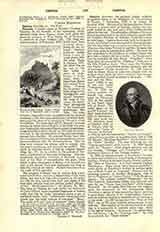

Canossa, a former castle of Matilda, Countess of Tuscany, in the foothills of the Apennines, about eighteen miles from Parma, where took place the dramatic penance of King Henry IV of Germany in presence of Pope Gregory VII. The king, excommunicated February 22, 1076, would have been utterly abandoned by the inimical German princes unless within a year he made peace with the pope. Early in January, 1077, the latter was on his way to the diet called to meet at Augsburg, February 2, when he heard that Henry had crossed Mont Cenis. Fearing for his person, he took refuge in the impregnable and almost inaccessible burg of Canossa, the hereditary stronghold of his friend and protectress, Matilde. The king, however, was really intent on performing the penance necessary to lift the excommunication, by which diplomatic step the plans of his enemies in Germany would be nullified. For three days (25-January 27) he stood constantly before the castle gate, in the dress of a penitent, beseeching with many tears the pope’s forgiveness. Gregory finally yielded, moved by the royal compunction and by the importunities of his royal entourage, among them Matilda. He received Henry back into the communion of the Church, and promised to promote his reconciliation with the German princes. But the king soon violated his solemn oath to comply with the pope’s conditions, and renewed the conflict. The story, as narrated above, is told by Gregory himself (Reg. Ep., IV, 12), in a letter to the princes of Germany explanatory of the event of Canossa. The contemporary chronicler, Lambert of Hersfeld, asserts that at the Mass of reconciliation the pope, when about to give communion to Henry, took himself one half of the Sacred Host and challenged the king to take the other as an ordeal. Modern historians deny the truth of this assertion.
The penance of Henry was, in reality, only a personal humiliation, and not a degradation of the royal office; nor was it in that form imposed by the pope, nor did the king spend three days and nights in bare shirt without food and without shelter (Hergenrother, “Kirchengeschichte”, ed. Kirsch, II, 361). The ruins of Canossa are now within the Commune of Ciano d’Enza, some shapeless fragments of broken walls that rise on rocky buttresses above a sea of hardened brown mud, “twisted and tossed and contorted into the most hideous of crevasses” (Hare). The castle-well and “gate of penance” alone remain.
THOMAS J. SHAHAN

